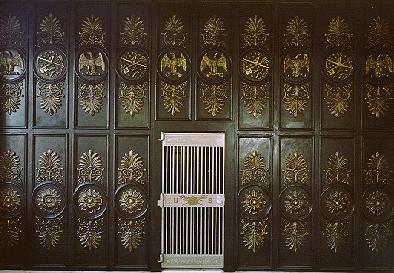The restored decorative case iron wall in the office of the Treasurer of the United States is the exterior wall of one of four burglar proof vaults built in the northwest corner of the Treasury Building in 1864. The vaults were designed and patented by Isaiah Rogers (1800-1869), who was Supervising Architect of the Treasury from 1863 through 1865. He was also Engineer in Charge, Bureau of Construction from 1861 through 1863.

In August 1985 the offices and three connecting vaults of the Securities Transactions Branch of the Bureau of the Public Debt were being renovated for the Treasurer of the United States. Rogers' 1864 vault, which had been hidden from view for nearly eighty years, was discovered sandwiched between two later vault extensions.
A metals conservator and an ironworker restored the exterior decorative cast iron wall of the vault to its original 1864 appearance. They preserved a cross section of the original vault lining on the inner office wall. The present day gate, a lattice door used to secure the vault during working hours, dates from a 1908 extension. The label above the door replicates one which was put on the vault at the time of its completion.
The design of the vault originated in 1862 when Rogers, the Engineer in Charge of the Treasury's Bureau of Construction, was called upon to assess the security of the various types of burglar proof vaults commercially available. This was a pressing concern, for secure vaults were needed not only in the Treasury Building itself, still under construction, but also in federal custom houses and post offices being built by the Treasury Department across the land. Judging the existing vaults insecure against burglars, Rogers devised a unique burglar proof vault lining. This lining consisted of interposing two layers of cast iron balls between the traditional alternating plates of wrought iron and hardened steel. The balls, held loosely in specially formed cavities, were designed to rotate freely upon contact with a drill, or any other tool, thereby preventing a burglar from penetrating the vault.
The design was first used for two vaults built in the New York Sub-Treasury, now Federal Hall, in 1862, by George R. Jackson, Burnet & Co. of New York. The construction was highly successful and Rogers received a patent for the design in 1863. In 1864, Isaiah Rogers, the Supervising Architect of the Treasury, contracted with George R. Jackson, Burnet & Co. to build four vaults using his patent in the Treasury Building. The same year similar vaults were built by George R. Jackson, Burnet & Co. in custom houses in Detroit, Cincinnati and Chicago.
In the Main Treasury Building the four vaults were built for the Treasurer of the United States and the Comptroller of the Currency. They were installed in the northwest corner of the North Wing, which was completed in 1864. The Office of the Treasurer was located on the entrance story and that of the Comptroller was on the floor above. Each of these offices had two vaults of Roger's patent for holding currency and bonds. These two offices worked closely to administer the newly developed National Banking System, inaugurated in 1863 by Secretary of the Treasury Salmon P. Chase. The Comptroller of the Currency was created the same year to supervise the national banks and to issue to the banks, from its vaults, the circulating monetary notes. Government bonds to secure the circulating notes were bought by the national banks, received and recorded by the Comptroller and deposited in the Treasurer's vaults.
This vault initially served as a Cashier's vault for the Treasurer of the United States. When that office was relocated in the newly opened Cash Room in 1869, it became a Bond Vault for the Division of National Banks. An identical vault on the floor above was used as a currency vault for the Comptroller of the Currency. That vault was removed in 1947 to create office space.
As the National Bank System grew, so did the amount of business conducted by the Comptroller of the Currency and the Treasurer of the United States, and it became necessary to increase the available vault space. In 1908 an extension was added to the west end of the Treasurer's Bond Vault, enclosing Rogers' decorative iron wall. A larger extension was added to the east end of the Treasurer's Bond Vault in 1933-1935.
Today money is not stored in the Treasury Building and vaults are no longer used. This historic vault wall stands as a tribute to the Treasurer of the United States, who was the original occupant of this office, and as a reminder of the days when the nation's currency passed through the Treasury's vaults.
ACKNOWLEDGEMENTS: We wish to thank the Office of the Curator for providing this material and helping to maintain it.
